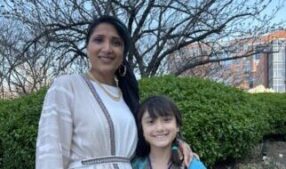I’ve been meaning to write about my journey to know myself more deeply through my relationship with my daughter for weeks now. But every time I sit down, something new unfolds—a fresh layer of insight, another crack in the armor I didn’t know I still wore. Honestly, this could be a whole series on its own: a chronicle of how my heart is healing as I raise my daughter using tools I never had access to as a child or even as an adult making life-altering decisions.
Right now, my daughter Kaiya is eight years old and in third grade. I taught this age group for over a decade—it’s my favorite stage of childhood. They’re not quite tweens, but they’re no longer little kids either. It’s a tender age when children begin to make sense of who they are in relation to the world, and the messages they receive—directly or not—start to land harder. And too often, those messages lean toward shame or inadequacy.
For me, eight was a pivotal year.
It was the first time I understood that I was different. Not just in appearance or family background, but in belief systems, values, and traditions. Growing up in a mostly white, non-immigrant community, I learned quickly that sharing my cultural identity and Muslim traditions didn’t make me popular. It made me feel othered. So I began to hide those parts of myself, both internally and externally, trying to blend in and belong.
That’s where the fracture started.
Now, as Kaiya stands at that same crossroads of identity, I find myself returning to the very parts of myself I once rejected. And surprisingly, the healing came not in therapy or solitude—but in Ramadan, and through her.
My sister was the catalyst this year. She created a beautiful Ramadan calendar for Kaiya—complete with small gifts and daily tasks, something Kaiya could engage with no matter whose home she was in. Through that simple gesture, she brought Ramadan into my daughter’s life in a joyful, meaningful way. What I didn’t expect was how it would reawaken parts of my own spirit.
Kaiya decided she wanted to fast. She completed her very first roza (day of fasting) with her father, and then fasted seven more days with me. Every evening, we shared our stories—mine from childhood, hers from her first attempts. I told her about the kids at school, the special treats, the little moments of pride and struggle. We made traditional street foods together for iftar. I wrote out the prayers in English, taught her how to say them in Arabic.
And in those moments, I remembered.
I remembered how religion once anchored me. I remembered the joy of belonging—to something spiritual, cultural, and familial. I remembered the beauty of rituals that connected me to my ancestors, even if I didn’t have the language for it back then.
For years, I’ve struggled with reconciling my faith, my culture, and the Western world I live in. I’ve forged my own spiritual path—one that has taken me beyond the bounds of organized religion. But watching my daughter embrace a part of herself that I once buried has given me permission to reclaim it, too.
As children, many of us gave up parts of ourselves just to fit in. We sacrificed pieces of our identity to feel accepted. But at some point, we wake up and realize something is missing—that the connection to our lineage, to the generations before us, has frayed. We feel that incompleteness deep in our bones.
Kaiya is stitching those pieces back together, simply by being herself. By letting me raise her in truth, in wholeness, in love. She is learning to celebrate all the parts of who she is—regardless of how others may perceive or understand her. And in doing so, she’s teaching me to do the same.
This is what healing looks like: two generations growing alongside one another. A mother reconnecting with her roots, and a daughter learning to stand proudly in hers.
If you take anything away from this, let it be this—your healing doesn’t have to be solitary. Sometimes, it comes in the most unexpected forms: through your children, through rituals you thought you’d left behind, through memories you finally feel safe enough to revisit.
And in that space, where the past meets the present, healing happens.
Together, Kaiya and I are learning. Together, we are remembering.
And together, we are coming home to ourselves.



Leave a Reply to Kenan Cancel reply